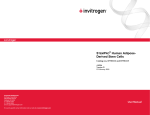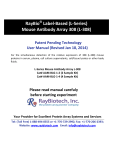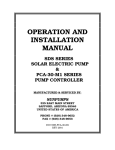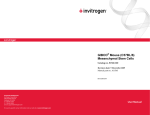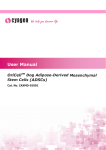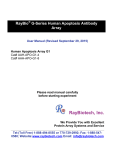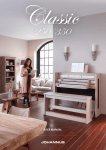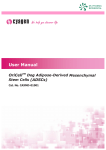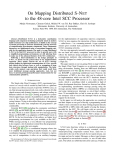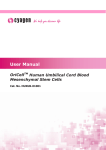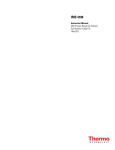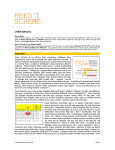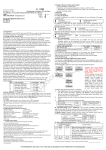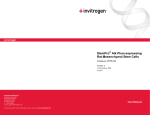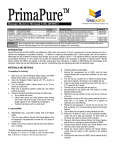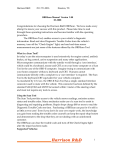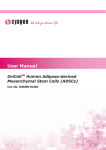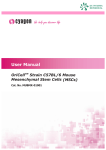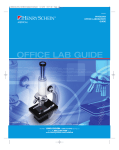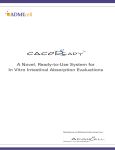Download StemPro ADSCs - Thermo Fisher Scientific
Transcript
STEMPRO® Human AdiposeDerived Stem Cells Catalog nos. R7788-110 and R7788-115 A10296 Version C 25 July 2008 Corporate Headquarters Invitrogen Corporation 1600 Faraday Avenue Carlsbad, CA 92008 T: 1 760 603 7200 F: 1 760 602 6500 E: [email protected] For country-specific contact information visit our web site at www.invitrogen.com User Manual ii Table of Contents Contents and Storage............................................................................................ v Additional Products............................................................................................. vi Introduction ............................................................................................................1 Methods............................................................................................... 4 General Information ..............................................................................................4 Preparing Complete MesenPRO RS™ Medium.................................................5 Thawing and Establishing Cells ..........................................................................6 Subculturing Cells..................................................................................................8 Freezing Cells........................................................................................................10 Osteogenic Differentiation Media and Methods.............................................13 Adipogenic Differentiation Media and Methods ...........................................15 Chondrogenic Differentiation Media and Methods.......................................18 Appendix ........................................................................................... 20 Troubleshooting ...................................................................................................20 Technical Support ................................................................................................21 Purchaser Notification.........................................................................................22 References..............................................................................................................24 iii iv Contents and Storage Catalog no. R7788-110 includes cells plus media. Kit Configurations Catalog no. R7788-115 includes cells only. Shipping STEMPRO® Human Adipose-Derived Stem Cells and MesenPRO RS™ Growth Supplement are shipped on dry ice. MesenPRO RS™ Basal Medium is shipped at room temperature. Kit Contents and Storage Kit components and storage conditions for R7788-110 and R7788-115 are listed in the table below. R7788-110 STEMPRO® Human Adipose-Derived Stem Cells (1 × 106 cells/ml in freezing medium) MesenPRO RS™ Basal Medium MesenPRO RS™ Growth Supplement R7788-115 STEMPRO® Human Adipose-Derived Stem Cells (1 × 106 cells/ml in freezing medium) Amount 1 ml 500 ml 10 ml Amount 1 ml Storage Liquid nitrogen 2 to 8°C in the dark –5 to –20°C in the dark Storage Liquid nitrogen Handle cells as potentially biohazardous material under at least Biosafety Level 1 containment. This product contains Dimethyl Sulfoxide (DMSO), a hazardous material. Review the Material Safety Data Sheet (MSDS) before handling. Product Qualification The Certificate of Analysis provides detailed quality control information for each product. Certificates of Analysis are available on our website. Go to www.invitrogen.com/support and search for the Certificate of Analysis by product lot number, which is printed on the box. v Additional Products The products listed in this section may be used with STEMPRO® Human Adipose-Derived Stem Cells. For more information, refer to our Web site (www.invitrogen.com) or contact Technical Support (see page 21). Additional Products Item Quantity Catalog no. 1 kit 12746-012 100 ml 25030-081 STEMPRO Osteogenesis Differentiation Kit 1 kit A10072-01 STEMPRO® Adipogenesis Differentiation Kit 1 kit A10070-01 Gentamicin (10 mg/ml) 10 ml 15710-064 Dulbecco’s Phosphate Buffered Saline (DPBS), containing no calcium, magnesium, or phenol red 500 ml 14190-144 ™ MesenPRO RS Medium (includes Basal Medium and Growth Supplement) L-glutamine (200 mM), liquid ® Fetal Bovine Serum, MSC-Qualified 100 ml 12662-011 TrypLE™ Express without phenol red 100 ml 12604-013 Antibiotic-Antimycotic (100X), liquid 100 ml 15240-062 Dulbecco's Modified Eagle Medium (DMEM) (1X) (low glucose) with 1,000 mg/l D-glucose and 110 mg/l sodium pyruvate—without L-glutamine and phenol red 500 ml 11054-020 L-glutamine (200 mM, liquid) 100 ml 25030-081 Dulbecco's Modified Eagle Medium (DMEM) (1X) (high glucose) with 4.5 g/l D-glucose and sodium pyruvate— without L-glutamine 500 ml 10312-021 Antibodies A variety of antibodies for characterizing ADSCs are available from Invitrogen. The following table lists catalog numbers for purified antibodies only. For labeled antibodies or additional information, refer to our Web site (www.invitrogen.com) or contact Technical Support (see page 21). Quantity Catalog no. CD 31 Mouse Anti-Human, Purified Item 100 μg MHCD3100 CD 90 Purified MS X HU (BioSource™) 100 μg AHU0051 CD 29, Mouse Anti-Human, Purified 100 μg CD2900 CD 14 Mouse Anti-Human, Purified 100 μg MHCD1400 CD 105 Mouse Anti-Human, Purified 100 μg MHCD10500 CD 44 Mouse Anti-Human, Purified 100 μg MHCD4400 CD 45 Mouse Anti-Human, Purified 100 μg MHCD4500 CD 73 (Host: Mouse, Clone: 7G2) 100 μg 41-0200 vi Introduction Introduction STEMPRO® Human Adipose-Derived Stem Cells (ADSCs) are isolated from human adipose tissue collected during liposuction procedures and cryopreserved from primary cultures. Before cryopreservation, the ADSCs are expanded for one passage in MesenPRO RS™ Medium. Each lot of ADSCs originates from a single donor of human lipoaspirate tissue. Each vial of ADSCs contains cells that can differentiate into multiple mature cell phenotypes in vitro, including adipocytes, osteoblasts, and chondrocytes (Fraser & Schreiber et al., 2006; Fraser & Wulur et al., 2006; Schäffler & Büchler, 2007; Strem et al., 2005). In vitro differentiation into nonmesenchymal cell types, such as neuronal and glial progenitors, hepatocytes and vascular endothelial progenitors have also been described (Rehman et al., 2004; Safford & Rice, 2005; Strem et al., 2005). In addition, ADSCs are known to secrete pro-angiogenic, immunomodulatory and anti-apoptotic factors (Puissant et al., 2005; Rehman et al., 2004; Yañez et al., 2006). ADSCs can be used for studies of adult stem cell differentiation, tissue engineering, and potential future clinical applications. They may also be used for the delivery of recombinant DNA constructs. MesenPRO RS™ Medium is recommended for use with these cells for optimal growth and expansion. Characteristics • Are prepared from low-passage (passage 1) adherent human adipose-derived primary cell cultures of STEMPRO® ADSCs • Express a flow-cytometry cell-surface protein profile positive for CD29, CD44, CD73, CD90, CD105, and CD166 (> 95%), and negative for CD14, CD31, CD45, and Lin1 (< 2%). • Contain cells characteristic of at least bi-potential differentiation Continued on next page 1 Introduction, continued Isolation and Expansion ADSCs are extracted from human adipose tissue through mechanical and enzymatic digestion. Cells are expanded using MesenPRO RS™ Medium, which supports a much shorter cell doubling time (36 +/- 4 hours) than traditional medium (DMEM + 10% FBS), resulting in a cell doubling time of 54 +/– 4 hours. ADSCs can be expanded to 4–5 passages before they lose their ability to grow or differentiate into all potential phenotypes. Differentiation Potential Multiple investigators have demonstrated that ADSCs can be differentiated towards multiple mature cell phenotypes. In addition to traditional mesenchymal lineages, ADSCs have been differentiated towards cardiomyocytic, pancreatic, epithelial, and other phenotypes using specialized media. Differentiation into Mesenchymal Cell Types The images below show the differentiation of ADSCs into mesenchymal cell types. A. ADSCs induced to differentiate towards chondrocytes for 29 days and then stained with safranin orange dye (pellet cross-sectional staining) for proteoglycan content; image captured using 4x objective lens. B. ADSCs induced to differentiate towards osteoblasts for 29 days and then stained with alizarin red dye (which stains mineralized extracellular matrix); image captured using 4x objective lens. C. ADSCs induced to differentiate towards adipocytes for 14 days and then stained with oil-red-O (which stains lipid vacuoles) and counterstained with hematoxylin; image captured using 10x objective lens. Continued on next page 2 Introduction, continued MesenPRO RS™ Medium MesenPRO RS™ Basal Medium and Growth Supplement have been developed for the growth and expansion of human mesenchymal stem cell-like cells, including ADSCs, in tissueculture vessels. Complete MesenPRO RS™ Medium is a reduced-serum medium (2% FBS) for reduced MSC doubling times, improved MSC expansion, and improved multilineage differentiation capability. Complete MesenPRO RS™ Medium provides the following advantages for culturing human ADSCs: • Consistently improves expansion compared to traditional medium (DMEM + 10% FBS). • Maintains multilineage differentiation capabilities • Eliminates time and money spent pre-qualifying FBS lots MesenPRO RS™ Basal Medium and Growth Supplement are included with catalog no. R7788-110 and are available separately for catalog no. R7788-115 (see page vi for ordering information). STEMPRO® Differentiation Kits The STEMPRO® Osteogenesis Differentiation Kit and Adipogenesis Differentiation Kit provide specialized media and reagents to promote pathway-specific differentiation of human MSC-like cells, including ADSCs, in tissue-culture vessels. Each kit contains media and reagents for inducing MSCs to be committed to the osteogenic or adipogenic pathway. Using STEMPRO® Differentiation Kits in combination with MesenPRO RS™ Medium or STEMPRO® MSC SFM provides a standardized culture workflow solution for MSC isolation, expansion, and differentiation into matrix-forming osteoblasts or lipid vesicle-forming adipocytes. 3 Methods General Information General Cell Handling Important Follow the general guidelines below to grow and maintain STEMPRO® Human Adipose-Derived Stem Cells. • All solutions and equipment that come in contact with the cells must be sterile. Always use proper sterile technique and work in a laminar flow hood. • Before starting experiments, ensure cells have been established (at least 1 passage), and also have some frozen stocks on hand. • For differentiation studies and other experiments, we recommend using cells below passage 5. • For general maintenance of cells, cell confluency should be 60–80%, cell viability should be at least 90%, and the growth rate should be in mid-logarithmic phase prior to subculturing. • When thawing or subculturing cells, transfer cells into pre-warmed medium. • Antibiotic-antimycotic containing penicillin, streptomycin, and amphotericin B may be used if required (see page vi for ordering information). It is very important to strictly follow the guidelines for culturing ADSCs in this manual to keep them undifferentiated. As with other human cell lines, when working with ADSCs, handle as potentially biohazardous material under at least Biosafety Level 1 containment. 4 Preparing Complete MesenPRO RS™ Medium Introduction Follow the instruction in this section for preparing Complete MesenPRO RS™ Medium. Materials Needed The following materials are required: • MesenPRO RS™ Basal Medium and MesenPRO RS™ Growth Supplement (included with catalog no. R7788-110 and available separately for catalog no. R7788-115; see page vi for ordering information) • L-glutamine, 200 mM, liquid (see page vi for ordering information) Preparing Complete MesenPRO RS™ Medium • Store all media components in the dark. • Thaw MesenPRO RS™ Growth Supplement at 2 to 8°C prior to use. Avoid repeated freeze-thaw cycles of the supplement. • Do not store the prepared complete MesenPRO RS™ Medium longer than 15 days. Prepare Complete MesenPRO RS™ Medium with MesenPRO RS™ Growth Supplement and L-glutamine prior to use, as follows. Store the complete medium in the dark at 2 to 8°C and use within 15 days. 1. Aseptically add 10 ml of MesenPRO RS™ Growth Supplement to 500 ml of MesenPRO RS™ Basal Medium 2. Aseptically add L-glutamine to the medium to a final concentration of 2 mM (e.g., add 5 ml of 200 mM L-glutamine stock to 500 ml of medium). 5 Thawing and Establishing Cells Introduction Follow the protocol below to thaw STEMPRO® ADSCs to initiate cell culture. Materials Needed The following materials are required (see page vi for ordering information). • STEMPRO® Human Adipose-Derived Stem Cells, stored in liquid nitrogen • Ethanol or isopropanol • Prepared Complete MesenPRO RS™ Medium (see previous page), prewarmed to 37°C • Disposable, sterile 50-ml tubes • 37°C water bath • 37°C incubator with a humidified atmosphere of 5% CO2 • Microcentrifuge • Tissue-culture treated 35-mm dish Thawing Procedure To thaw and establish STEMPRO® ADSCs: 1. Prewarm prepared Complete MesenPRO RS™ Medium to 37°C. 2. Remove the cells from liquid nitrogen storage, and wipe the cryovial with ethanol or isopropanol before opening. In an aseptic field, briefly twist the cap a quarter turn to relieve pressure and then retighten. Do not expose cells to air before thawing. 3. Quickly thaw the vial of cells by swirling it in a 37°C water bath and removing it when the last bit of ice has melted, typically < 2 minutes. Do not submerge the vial completely. Do not thaw the cells for longer than 2 minutes. 4. When thawed, immediately transfer cells into a 50-ml sterile tube and add prewarmed Complete MesenPRO RS™ Medium dropwise up to 10 ml. 5. Centrifuge cells for 5 minutes at 210 × g. 6. Aspirate supernatant. Procedure continued on next page Continued on next page 6 Thawing and Establishing Cells, continued Thawing Procedure, continued Procedure continued from previous page 7. Resuspend cells in Complete MesenPRO RS™ Medium (2 ml for a 35-mm dish) and plate the resuspended cells. The recommended seeding density for AdiposeDerived Stem Cells is 5,000 cells per cm2. 8. Incubate at 37°C, 5% C02 and 90% humidity and allow cells to adhere for several hours (or overnight). 9. When the cells have attached to the growth surface, replace the medium with an equal volume of fresh, prewarmed Complete MesenPRO RS™ Medium. 10. Change the medium every 3-4 days. 7 Subculturing Cells Introduction Follow the protocol below to culture ADSCs. Subculture cells when needed (before colonies start contacting each other), typically every 10-14 days. Materials Needed The following materials are required (see page vi for ordering information). Passaging Cells • Culture vessels containing ADSCs • Tissue-culture treated flasks, plates or dishes • Complete MesenPRO RS™ Medium, prewarmed to 37°C • Disposable, sterile 15-ml tubes • 37°C incubator with humidified atmosphere of 5% CO2 • Dulbecco’s Phosphate Buffered Saline (DPBS), containing no calcium, magnesium, or phenol red • TrypLE™ Express, without phenol red • Hemacytometer or cell counter • Trypan blue 1. Aspirate the Complete MesenPRO RS™ Medium from the cells. 2. Rinse the surface of the cell layer with DPBS (approximately 2 ml DPBS/10 cm2 culture surface area), by adding the DPBS to the side of the vessel opposite the attached cell layer and rocking back and forth several times. 3. Remove the DPBS by aspiration and discard. 4. To detach the cells, add a sufficient volume of prewarmed TrypLE™ Express without phenol red to cover the cell layer (approx. 0.5 ml/10 cm2). 5. Incubate at 37˚C for approximately 7 minutes. 6. Observe the cells under a microscope. If the cells are less than 90% detached, continue incubating and observe within 2 minutes for complete detachment of the cells. Tap the vessel to expedite cell detachment. Procedure continued on next page Continued on next page 8 Subculturing Cells, continued Passaging Cells, continued Procedure continued from previous page 7. When ≥ 90% of the cells have detached, tilt the vessel for a minimal length of time to allow the cells to drain. Add the equivalent of 2 volumes (twice the volume used for the TrypLE™ Express) of temperatureequilibrated Complete MesenPRO RS™ Medium. 8. Disperse the medium by pipetting over the cell layer surface several times. 9. Transfer the cells to a 15-ml conical tube and centrifuge at 210 × g for 5 minutes at room temperature. 10. Resuspend the cell pellet in a minimal volume of temperature-equilibrated Complete MesenPRO RS™ Medium and remove a sample for counting. 11. Determine the total number of cells and percent viability using a hemacytometer or cell counter and Trypan Blue exclusion. If necessary, add Complete MesenPRO RS™ Medium to the cells to achieve the desired cell concentration and recount the cells. 12. Determine the total number of vessels to inoculate by using the following equation: Number of vessels = Number of viable cells ÷ (growth area of vessel in cm2 × 5,000 cells per cm2 recommended seeding density) 13. Add Complete MesenPRO RS™ Medium to each vessel so that the final culture volume is 0.2–0.5 ml per cm2. 14. Add the appropriate volume of cells to each vessel and incubate at 37°C, 5% C02 and 90% humidity. 15. Three to four days after seeding, completely remove the medium. Replace with an equal volume of Complete MesenPRO RS™ Medium. 9 Freezing Cells Introduction Guidelines and procedures for preparing freezing medium and freezing cells are provided in this section. Materials Needed The following materials are required (see page vi for ordering information). Guidelines • Culture vessels containing ADSCs • Complete MesenPRO RS™ Medium • Fetal Bovine Serum, MSC-Qualified • DMSO (use a bottle set aside for cell culture; open only in a laminar flow hood) • Disposable, sterile 15-ml conical tubes. • DPBS, containing no calcium, magnesium, or phenol red • TrypLE™ Express, without phenol red • Hemacytometer or cell counter • Sterile freezing vials When freezing ADSCs, we recommend the following: • Freeze cells at a density of 1–2 × 106 viable cells/ml. • Use a freezing medium composed of final concentrations of 20% Fetal Bovine Serum (MSC Cell-qualified) and 10% DMSO. • Bring the cells into freezing medium in two steps, as described in this section. Continued on next page 10 Freezing Cells, continued Preparing Freezing Media Prepare Freezing Medium A and B immediately before use. You will need enough of each freezing medium to resuspend cells at a density of 1–2 × 106 cells/ml (see the freezing procedure below). 1. In a sterile 15-ml tube, mix together the following reagents for every 1 ml of Freezing Medium A needed: Complete MesenPRO RS™ Medium Fetal Bovine Serum, MSC-Qualified 2. In another sterile 15-ml tube, mix together the following reagents for every 1 ml of Freezing Medium B needed: Complete MesenPRO RS™ Medium DMSO 3. 0.6 ml 0.4 ml 0.8 ml 0.2 ml Place tube with Freezing Medium B on ice until use (leave Freezing Medium A at Room Temperature). Note: Discard any remaining freezing medium after use. Freezing Cells Procedure 1. Aspirate Complete MesenPRO RS™ Medium from the flask, well, or dish. 2. Rinse the surface with DPBS (approximately 2 ml DPBS/10 cm2 culture surface area) by adding the DPBS to the side of the vessel opposite the attached cell layer and rocking back and forth several times. 3. Remove the DPBS by aspiration and discard. 4. To detach the cells, add a sufficient volume of prewarmed TrypLE™ Express without phenol red to cover the cell layer (approx. 0.5 ml/10 cm2). 5. Incubate at 37°C for approximately 7 minutes. 6. Observe the cells under a microscope. If the cells are less than 90% detached, continue incubating and observe within 2 minutes for complete detachment of the cells. Tap the vessel to expedite cell detachment. Procedure continued on next page Continued on next page 11 Freezing Cells, continued Freezing Cells Procedure, continued Procedure continued from previous page 7. When ≥90% of the cells have detached, tilt the vessels on end for a minimal length of time to allow the cells to drain. Add the equivalent of 2 volumes (twice the volume used for the TrypLE™ Express) of temperatureequilibrated Complete MesenPRO RS™ Medium to each vessel. 8. Disperse the medium by pipetting over the cell layer surface several times. 9. Transfer the cells to a 15-ml conical tube and centrifuge at 210 × g for 5 minutes at room temperature. 10. Resuspend the cell pellet in a minimal volume of temperature-equilibrated Complete MesenPRO RS™ Medium and remove a sample for counting. 11. Determine the total number of cells using a hemacytometer or cell counter. 12. Gently aspirate media from the vessel and resuspend the cells to a concentration of 4 × 106 cells/ml in Freezing Medium A. 13. Add the same volume of Freezing Medium B to cells in a dropwise manner. 14. Aliquot 1 ml to each freezing vial and store at –80°C overnight in an isopropanol chamber. 15. The next day, transfer the frozen vials to a liquid nitrogen tank for long-term storage. Note: You may check the viability and recovery of frozen cells 24 hours after storing cryovials in liquid nitrogen by following the procedure outlined in Thawing and Establishing Cells, page 6. 12 Osteogenic Differentiation Media and Methods Introduction This section provides media-preparation guidelines and a protocol for inducing STEMPRO® ADSCs to differentiate towards osteoblasts using the STEMPRO® Osteogenesis Differentiation Kit. Materials Needed The following materials are required (see page vi for ordering information). • STEMPRO® Osteogenesis Differentiation Kit • Gentamicin (10 mg/ml) • Culture vessels containing ADSCs • DPBS without Ca++ and Mg++ • TrypLE™ Express, without phenol red • Tissue-culture treated vessels • Disposable, sterile 15-ml tubes • 37°C incubator with humidified atmosphere of 5% CO2 • Hemacytometer or cell counter StemPro® Osteogenesis Differentiation Kit The STEMPRO® Osteogenesis Differentiation Kit provides specialized media and reagents for osteogenic differentiation of ADSCs in tissue-culture vessels. See the insert provided with the kit for detailed information and protocols. Preparing Complete Differentiation Medium To prepare Complete STEMPRO® Osteogenesis Differentiation Medium, thaw the STEMPRO® Osteogenesis Supplement at 4°C, room temperature, or in a 37°C water bath, and prepare as below. Store complete medium at 2–8°C in the dark. Component Final Conc. For 100 ml STEMPRO Osteocyte/Chondrocyte Differentiation Basal Medium 1X 90 ml STEMPRO® Osteogenesis Supplement 1X 10 ml 5 μg/ml 50 μl ® Gentamicin (10 mg/ml) Continued on next page 13 Osteogenic Differentiation Media and Methods, continued Preparing an Osteogenic Cell Culture 14 1. Observe the ADSC monolayer to ensure mid-log growth phase confluence (60–80%). Aspirate the medium and floating cells from the culture flask and discard. 2. Add 5–10 ml DPBS to the flask. Gently rinse the cell monolayer. 3. Remove DPBS and add 5–7 ml of pre-warmed TrypLE™ Express to the flask and completely coat the culture surface. Incubate for 5–8 minutes at 36–38°C or until cells have fully detached. 4. Gently pipet detached cells into a single-cell solution and verify on inverted microscope. 5. Remove the cell suspension from the flask, transfer into a centrifuge tube, and pellet cells at 100 × g for 5–10 minutes. 6. Determine cell viability and total cell density using Trypan Blue Stain and electronic (i.e., Coulter Counter) or manual (i.e., hemocytometer) cell counting method. 7. Resuspend the pellet in an appropriate volume of prewarmed Complete MesenPRO RS™ Medium. 8. Seed the ADSCs into culture vessels at 5 × 103 cells/cm2. For classical stain differentiation assays, seed into a 12-well plate. For gene-expression profile studies, seed into a T-75 flask. For immunocytochemistry studies, seed into a 16-well CultureWell™ chambered coverglass or 96well plate. 9. Incubate in Complete MesenPRO RS™ Medium at 36–38°C in a humidified atmosphere of 4–6% CO2 for a minimum of 2 hours up to 4 days. 10. Replace media with pre-warmed Complete STEMPRO® Osteogenesis Differentiation Medium and continue incubation. ADSCs will continue to expand as they differentiate under osteogenic conditions. Refeed cultures every 3–4 days. 11. After specific periods of cultivation, osteogenic cultures can be processed for alkaline phosphatase staining (7– 14 days) or Alizarin Red S staining (>21 days), gene expression analysis, or protein detection. Adipogenic Differentiation Media and Methods Introduction This section provides media-preparation guidelines and a protocol for inducing STEMPRO® ADSCs to differentiate towards adipocytes using the STEMPRO® Adipogenesis Differentiation Kit. Materials Needed The following materials are required (see page vi for ordering information). • STEMPRO® Adipogenesis Differentiation Kit • Gentamicin (10 mg/ml) • Culture vessels containing ADSCs • DPBS without Ca++ and Mg++ • TrypLE™ Express, without phenol red • Tissue-culture treated vessels • Disposable, sterile 15-ml tubes • 37°C incubator with humidified atmosphere of 5% CO2 • Hemacytometer or cell counter StemPro® Adipogenesis Differentiation Kit The STEMPRO® Adipogenesis Differentiation Kit provides specialized media and reagents for adipogenic differentiation of ADSCs in tissue-culture vessels. See the insert provided with the kit for detailed information and protocols. Complete Adipogenic Differentiation Medium To prepare the complete medium, thaw the supplement in a 37±2°C water bath, swirl and warm the supplement to promote dissolution of the precipitate (see Note on the following page), and prepare the medium as described in the table below. Store complete medium at 2–8°C in the dark. Component Final Conc. For 100 ml STEMPRO Adipocyte Differentiation Basal Medium 1X 90 ml STEMPRO® Adipogenesis Supplement 1X 10 ml 5 μg/ml 50 μl ® Gentamicin (10 mg/ml) Continued on next page 15 Adipogenic Differentiation Media and Methods, continued It is normal to see a precipitate formed in the supplement after thawing. To promote dissolution of the precipitate, warm the supplement with swirling for no more than 30 minutes prior to preparing complete media. Any remaining precipitate should be suspended in solution before it is added to STEMPRO® Adipocyte Differentiation Basal Medium, and will dissolve completely when mixed with the Basal Medium and warmed. Preparing an Adipogenic Cell Culture 1. Observe the ADSC monolayer to ensure mid-log growth phase confluence (60–80%). Aspirate the medium and floating cells from culture flask and discard. 2. Add 5–10 ml DPBS. Gently rinse the cell monolayer. 3. Remove the DPBS and add 5–7 ml of pre-warmed TrypLE™ Express to the flask and completely coat the culture surface. Incubate for 5–8 minutes at 36–38°C or until cells have fully detached. 4. Gently pipet the detached cells into a single-cell solution and verify on inverted microscope. 5. Remove the cell suspension from the flask, transfer into a centrifuge tube, and pellet cells at 100 × g for 5–10 minutes. 6. Determine cell viability and total cell density using Trypan Blue Stain and electronic (i.e., Coulter Counter) or manual (i.e., hemocytometer) cell counting method. 7. Resuspend the pellet in an appropriate volume of prewarmed Complete MesenPRO RS™ Medium. 8. Seed the ADSCs into culture vessels at 1 × 104 cells/cm2. For classical stain differentiation assay, seed into a 12 well plate. For gene expression profile studies, seed into a T-75 flask. For immunocytochemistry studies, seed into a 16-well CultureWell™ chambered coverglass or 96well plate. 9. Incubate in Complete MesenPRO RS™ Medium at 36–38°C in a humidified atmosphere of 4–6% CO2 for a minimum of 2 hours up to 4 days. Procedure continued on the next page Continued on next page 16 Adipogenic Differentiation Media and Methods, continued Preparing an Adipogenic Cell Culture, continued Procedure continued from the previous page 10. Replace media with pre-warmed Complete Adipogenesis Differentiation Medium and continue incubation. ADSCs will continue to undergo limited expansion as they differentiate under adipogenic conditions. Refeed cultures every 3–4 days. 11. After specific periods of cultivation, adipogenic cultures can be processed for Oil Red O or LipidTOX™ staining (beginning at 7–14 days), gene expression analysis or protein detection. 17 Chondrogenic Differentiation Media and Methods Introduction This section provides media-preparation guidelines and a protocol for inducing STEMPRO® ADSCs to differentiate towards chondrocytes using published recipes (Mackay et al., 1998; Pittenger et al., 1999). Materials Needed The following materials are required (see page vi for ordering information). Chondrogenic Differentiation (CD) Medium • Chondrogenic differentiation medium (see below) • Culture vessels containing ADSCs • DPBS without Ca++ and Mg++ • TrypLE™ Express, without phenol red • Tissue-culture treated vessels • Disposable, sterile 15-ml tubes • 37°C incubator with humidified atmosphere of 5% CO2 • Hemacytometer or cell counter Chondrogenic Differentiation Medium is prepared as follows. Store the prepared medium in the dark at 2 to 8°C. Component Source Cat. no. Volume Conc. DMEM low glucose, without L-glutamine and phenol red Invitrogen 11054-020 100 ml — 200 mM L-glutamine Invitrogen 25030-081 1 ml 2 mM Insulin-Transferrin-SeleniumPlus BD Biosciences 354352 1 ml 1X 50 mM L-ascorbic acid Sigma A8960-5G 100 μl 50 μM 40 mg/ml L-proline Sigma P5607 100 μl 40 μg/ml 100 μM dexamethasone Sigma D8893 100 μl 0.1 μM 10 μg/ml recombinant human TGF-beta 3 (BioSource) Invitrogen 10 mg/ml gentamicin Invitrogen PHG9304 15710-064 100 μl 50 μl 10 ng/ml 5 μg/ml Continued on next page 18 Chondrogenic Differentiation Media and Methods, continued Preparing a Chondrogenic Cell Culture 1. Detach cells using TrypLE™ Express and perform a cell count as described in Passaging Cells, pages 8–9 (through Step 10). 2. Resuspend the cells in DMEM (low glucose) with 10% MSC-qualified FBS to a concentration of 8 × 106 cells/ml. 3. To six wells in a 12-well tissue-culture dish, spot 10 μl of cells per well. 4. Incubate for two hours at 37°C, 5% C02 and 90% humidity. 5. To three of the spotted wells, add 1 ml of DMEM (low glucose) with 10% MSC-qualified FBS. To the other three wells, add 1 ml of Chondrogenic Differentiation Medium (prepared as described above). 6. Incubate at 37°C, 5% C02 and 90% humidity. Refeed cultures every three to four days with same media, prepared at the initiation of differentiation. 7. Check for chondrogenesis after a set period of cultivation. You can perform alcian blue staining to detect glycosaminoglycans or collagen 2a immunostaining after ~28 days. 19 Appendix Troubleshooting Culturing Cells The table below lists some potential problems and solutions that help you troubleshoot your cell culture problems. Problem Cause No viable cells after thawing stock Stock not stored correctly Home-made stock not viable Thawing medium not correct Cells too diluted Cells grow slowly Growth medium not correct Cells too old Cells differentiated Culture conditions not correct Cells too old 20 Solution Order new stock and store in liquid nitrogen. Keep in liquid nitrogen until thawing. Freeze cells at a density of 1–2 × 106 viable cells/ml. Use low-passage cells to make your own stocks. Follow procedures in Freezing Cells (page 10) exactly. Slow freezing and fast thawing is the key. Add Freezing Medium B drop wise manner (slowly). At time of thawing, thaw quickly and do not expose vial to the air but quickly change from nitrogen tank to 37°C water bath. Obtain new STEMPRO® ADSCs. Use prewarmed Complete MesenPRO RS™ Medium, prepared as described on page 5. Generally we recommend thawing one vial in a 35-mm dish at a density of 5,000 cells per cm2. Use prewarmed Complete MesenPRO RS™ Medium. Use healthy ADSCs, under passage 5; do not overgrow. Thaw and culture fresh vial of STEMPRO® ADSCs. Follow thawing instructions (page 6) and subculture procedures (page 8) exactly. ADSCs above passage 5 may become differentiated. Technical Support Web Resources Contact Us Visit the Invitrogen Web site at www.invitrogen.com for: • Technical resources, including manuals, vector maps and sequences, application notes, MSDSs, FAQs, formulations, citations, handbooks, etc. • Complete technical service contact information • Access to the Invitrogen Online Catalog • Additional product information and special offers For more information or technical assistance, call, write, fax, or email. Additional international offices are listed on our Web page (www.invitrogen.com). Corporate Headquarters: Invitrogen Corporation 5791 Van Allen Way Carlsbad, CA 92008 USA Tel: 1 760 603 7200 Tel (Toll Free): 1 800 955 6288 Fax: 1 760 602 6500 E-mail: [email protected] European Headquarters: Invitrogen Ltd Inchinnan Business Park 3 Fountain Drive Paisley PA4 9RF, UK Tel: +44 (0) 141 814 6100 Tech Fax: +44 (0) 141 814 6117 E-mail: [email protected] Material Safety Data Sheets (MSDSs) MSDSs (Material Safety Data Sheets) are available on our website at www.invitrogen.com/msds. Certificate of Analysis The Certificate of Analysis provides detailed quality control information for each product. Certificates of Analysis are available on our website. Go to www.invitrogen.com/support and search for the Certificate of Analysis by product lot number, which is printed on the box. 21 Purchaser Notification Limited Warranty Invitrogen is committed to providing our customers with high-quality goods and services. Our goal is to ensure that every customer is 100% satisfied with our products and our service. If you should have any questions or concerns about an Invitrogen product or service, contact our Technical Support Representatives. Invitrogen warrants that all of its products will perform according to specifications stated on the certificate of analysis. The company will replace, free of charge, any product that does not meet those specifications. This warranty limits Invitrogen Corporation’s liability only to the cost of the product. No warranty is applicable unless all product components are stored in accordance with instructions. Invitrogen reserves the right to select the method(s) used to analyze a product unless Invitrogen agrees to a specified method in writing prior to acceptance of the order. Invitrogen makes every effort to ensure the accuracy of its publications, but realizes that the occasional typographical or other error is inevitable. Therefore Invitrogen makes no warranty of any kind regarding the contents of any publications or documentation. If you discover an error in any of our publications, please report it to our Technical Support representatives. Invitrogen assumes no responsibility or liability for any special, incidental, indirect or consequential loss or damage whatsoever. The above limited warranty is sole and exclusive. No other warranty is made, whether expressed or implied, including any warranty of merchantability or fitness for a particular purpose. 22 Purchaser Notification, continued Limited Use Label License No. 5: Invitrogen Technology The purchase of this product conveys to the buyer the nontransferable right to use the purchased amount of the product and components of the product in research conducted by the buyer (whether the buyer is an academic or for-profit entity). The buyer cannot sell or otherwise transfer (a) this product (b) its components or (c) materials made using this product or its components to a third party or otherwise use this product or its components or materials made using this product or its components for Commercial Purposes. The buyer may transfer information or materials made through the use of this product to a scientific collaborator, provided that such transfer is not for any Commercial Purpose, and that such collaborator agrees in writing (a) not to transfer such materials to any third party, and (b) to use such transferred materials and/or information solely for research and not for Commercial Purposes. Commercial Purposes means any activity by a party for consideration and may include, but is not limited to: (1) use of the product or its components in manufacturing; (2) use of the product or its components to provide a service, information, or data; (3) use of the product or its components for therapeutic, diagnostic or prophylactic purposes; or (4) resale of the product or its components, whether or not such product or its components are resold for use in research. For products that are subject to multiple limited use label licenses, the most restrictive terms apply. Invitrogen Corporation will not assert a claim against the buyer of infringement of patents owned or controlled by Invitrogen Corporation which cover this product based upon the manufacture, use or sale of a therapeutic, clinical diagnostic, vaccine or prophylactic product developed in research by the buyer in which this product or its components was employed, provided that neither this product nor any of its components was used in the manufacture of such product. If the purchaser is not willing to accept the limitations of this limited use statement, Invitrogen is willing to accept return of the product with a full refund. For information on purchasing a license to this product for purposes other than research, contact Licensing Department, Invitrogen Corporation, 1600 Faraday Avenue, Carlsbad, California 92008. Phone (760) 6037200. Fax (760) 602-6500. Email: [email protected]. 23 References Fraser, J. K., Schreiber, R., Strem, B., Zhu, M., Alfonso, Z., Wulur, I., and Hedrick, M. H. (2006) Plasticity of human adipose stem cells toward endothelial cells and cardiomyocytes. Nat Clin Pract Cardiovasc Med, 3, S33-37 Fraser, J. K., Wulur, I., Alfonso, Z., and Hedrick, M. H. (2006) Fat tissue: an underappreciated source of stem cells for biotechnology. Trends Biotechnol., 24, 150-154 Mackay, A. M., Beck, S. C., Murphy, J. M., Barry, F. P., Chichester, C. O., and Pittenger, M. F. (1998) Chondrogenic differentiation of cultured human mesenchymal stem cells from marrow. Tissue Eng, 4, 415-428 Pittenger, M. F., Mackay, A. M., Beck, S. C., Jaiswal, R. K., Douglas, R., Mosca, J. D., Moorman, M. A., Simonetti, D. W., Craig, S., and Marshak, D. R. (1999) Multilineage potential of adult human mesenchymal stem cells. Science, 284, 143-147 Puissant, B., Barreau, C., Bourin, P., Clavel, C., Corre, J., Bousquet, C., Taureau, C., Cousin, B., Abbal, M., Laharrague, P., Penicaud, L., Casteilla, L., and Blancher, A. (2005) Immunomodulatory effect of human adipose tissuederived adult stem cells: Comparison with bone marrow mesenchymal stem cells. Br J Haematol, 129, 118-129 Rehman, J., Traktuev, D., Li, J., Merfeld-Clauss, S., Temm-Grove, C. J., Bovenkerk, J. E., Pell, C. L., Johnstone, B. H., Considine, R. V., and March, K. L. (2004) Secretion of angiogenic and antiapoptotic factors by human adipose stromal cells. Circulation, 109, 1292-1298 Safford, K. M., and Rice, H. E. (2005) Stem cell therapy for neurologic disorders: Therapeutic potential of adipose-derived stem cells. Current Drug Targets, 6, 57-62(56) Schäffler, A., and Büchler, C. (2007) Concise review: adipose tissue-derived stromal cells--basic and clinical implications for novel cell-based therapies. Stem Cells, 25, 818 – 827 Strem, B. M., Hicok, K. C., Zhu, M., Wulur, I., Alfonso, Z., Schreiber, R. E., Fraser, J. K., and Hedrick, M. H. (2005) Multipotential differentiation of adipose tissue-derived stem cells. Keio J Med, 54, 132-141 Yañez, R., Lamana, M. L., García-Castro, J., Colmenero, I., Ramírez, M., and Bueren, J. A. (2006) Adipose tissue-derived mesenchymal stem cells have in vivo immunosuppressive properties applicable for the control of the graftversus-host disease. Stem Cells, 24, 2582-2591 ©2007–2008 Invitrogen Corporation. All rights reserved. For research use only. Not intended for any animal or human therapeutic or diagnostic use. 24 Corporate Headquarters Invitrogen Corporation 5791 Van Allen Way Carlsbad, CA 92008 T: 1 760 603 7200 F: 1 760 602 6500 E: [email protected] For country-specific contact information, visit our web site at www.invitrogen.com User Manual
































